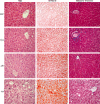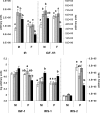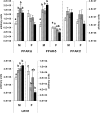A maternal "junk food" diet in pregnancy and lactation promotes nonalcoholic Fatty liver disease in rat offspring
- PMID: 20207831
- PMCID: PMC2850233
- DOI: 10.1210/en.2009-1192
A maternal "junk food" diet in pregnancy and lactation promotes nonalcoholic Fatty liver disease in rat offspring
Abstract
With rising obesity rates, nonalcoholic fatty liver disease is predicted to become the main cause of chronic liver disease in the next decades. Rising obesity prevalence is attributed to changes in dietary habits with increased consumption of palatable junk foods, but maternal malnutrition also contributes to obesity in progeny. This study examines whether a maternal junk food diet predisposes offspring to nonalcoholic fatty liver disease. The 144 rat offspring were fed either a balanced chow diet alone or with palatable junk foods rich in energy, fat, sugar, and/or salt during gestation, lactation, and/or after weaning up to the end of adolescence. Offspring fed junk food throughout the study exhibited exacerbated hepatic steatosis, hepatocyte ballooning, and oxidative stress response compared with offspring given free access to junk food after weaning only. These offspring also displayed sex differences in their hepatic molecular metabolic adaptation to diet-induced obesity with increased expression of genes associated with insulin sensitivity, de novo lipogenesis, lipid oxidation, and antiinflammatory properties in males, whereas the gene expression profile in females was indicative of hepatic insulin resistance. Hepatic inflammation and fibrosis were not detected indicating that offspring had not developed severe steatohepatitis by the end of adolescence. Hepatic steatosis and increased oxidative stress response also occurred in offspring born to junk food-fed mothers switched to a balanced chow diet from weaning, highlighting a degree of irreversibility. This study shows that a maternal junk food diet in pregnancy and lactation contributes to the development of nonalcoholic fatty liver disease in offspring.
Figures






Similar articles
-
Offspring from mothers fed a 'junk food' diet in pregnancy and lactation exhibit exacerbated adiposity that is more pronounced in females.J Physiol. 2008 Jul 1;586(13):3219-30. doi: 10.1113/jphysiol.2008.153817. Epub 2008 May 8. J Physiol. 2008. PMID: 18467362 Free PMC article.
-
A maternal 'junk food' diet in pregnancy and lactation promotes an exacerbated taste for 'junk food' and a greater propensity for obesity in rat offspring.Br J Nutr. 2007 Oct;98(4):843-51. doi: 10.1017/S0007114507812037. Epub 2007 Aug 15. Br J Nutr. 2007. PMID: 17697422
-
Perinatal exposure to bisphenol A exacerbates nonalcoholic steatohepatitis-like phenotype in male rat offspring fed on a high-fat diet.J Endocrinol. 2014 Sep;222(3):313-25. doi: 10.1530/JOE-14-0356. J Endocrinol. 2014. PMID: 25112833
-
Developmental origins of nonalcoholic fatty liver disease.Pediatr Res. 2014 Jan;75(1-2):140-7. doi: 10.1038/pr.2013.193. Epub 2013 Nov 5. Pediatr Res. 2014. PMID: 24192698 Free PMC article. Review.
-
Mitochondrial role in the neonatal predisposition to developing nonalcoholic fatty liver disease.J Clin Invest. 2018 Aug 31;128(9):3692-3703. doi: 10.1172/JCI120846. Epub 2018 Aug 31. J Clin Invest. 2018. PMID: 30168806 Free PMC article. Review.
Cited by
-
Developmental origins of NAFLD: a womb with a clue.Nat Rev Gastroenterol Hepatol. 2017 Feb;14(2):81-96. doi: 10.1038/nrgastro.2016.160. Epub 2016 Oct 26. Nat Rev Gastroenterol Hepatol. 2017. PMID: 27780972 Free PMC article. Review.
-
Oxidative Stress as Cause, Consequence, or Biomarker of Altered Female Reproduction and Development in the Space Environment.Int J Mol Sci. 2018 Nov 23;19(12):3729. doi: 10.3390/ijms19123729. Int J Mol Sci. 2018. PMID: 30477143 Free PMC article. Review.
-
Physical exercise and liver "fitness": Role of mitochondrial function and epigenetics-related mechanisms in non-alcoholic fatty liver disease.Mol Metab. 2020 Feb;32:1-14. doi: 10.1016/j.molmet.2019.11.015. Epub 2019 Nov 29. Mol Metab. 2020. PMID: 32029220 Free PMC article. Review.
-
Maternal Western-style high fat diet induces sex-specific physiological and molecular changes in two-week-old mouse offspring.PLoS One. 2013 Nov 5;8(11):e78623. doi: 10.1371/journal.pone.0078623. eCollection 2013. PLoS One. 2013. PMID: 24223833 Free PMC article.
-
Vertical Transfer of Maternal Gut Microbes to Offspring of Western Diet-Fed Dams Drives Reduced Levels of Tryptophan Metabolites and Postnatal Innate Immune Response.Nutrients. 2024 Jun 8;16(12):1808. doi: 10.3390/nu16121808. Nutrients. 2024. PMID: 38931163 Free PMC article.
References
-
- Adams LA, Lindor KD 2007 Nonalcoholic fatty liver disease. Ann Epidemiol 17:863–869 - PubMed
-
- Neuschwander-Tetri BA 2005 Nonalcoholic steatohepatitis and the metabolic syndrome. Am J Med Sci 330:326–335 - PubMed
-
- Day CP, James OF 1998 Steatohepatitis: a tale of two “hits?” Gastroenterology 114:842–845 - PubMed
-
- Pérez-Carreras M, Del Hoyo P, Martín MA, Rubio JC, Martín A, Castellano G, Colina F, Arenas J, Solis-Herruzo JA 2003 Defective hepatic mitochondrial respiratory chain in patients with nonalcoholic steatohepatitis. Hepatology 38:999–1007 - PubMed

